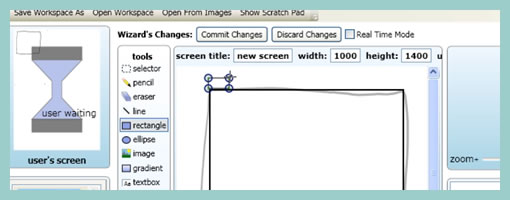SketchWizard
October 21st, 2010
A rather interesting experimental wizard of oz sketching tool has been developed a few years ago by a group at the University of Washington. The setup requires two separate monitors with the user on one and the designer on another. The person evaluating the prototype can then use a standard computer or a pen based input to perform actions on one monitor. While the screen pauses on the user’s monitor, the designer (acting as the wizard) then spontaneously draws up or selects what the user will see as a consequence, and so on.
Today’s popular prototyping tools for the most part rely on a similar approach to handling interactivity, which might be a bit stale. There is a large focus on trying to predict all possible interactions in advance and prerecording event handlers (such as onclicks and mouseovers) ahead of time. I find SketchWizard on the other hand provides a more spontaneous way of playing out interactions with a prototype. While it alleviates the need to have everything thought out before hand, the one catch might be that the user has to occasionally wait a few seconds longer before a new screen comes into view (as the designer is preparing it quietly on the other end). Perhaps it would be interesting to see more prototyping tools take on this approach as well.
There are binary releases and videos available right there on the project page.
Credits: Richard C. Davis, T. Scott Saponas, James A. Landay
























October 22nd, 2010 at 5:11 am
This would be very nice a very nice idea for some of the web apps to consider… real-time feedback <3
October 22nd, 2010 at 12:13 pm
A whole new level of pressure…The user is waiting. Got to create a screen NOWWWW!
October 23rd, 2010 at 2:01 am
Screenshot is very appealing
Currently not able to go to the url
October 25th, 2010 at 4:47 pm
Funny :) Well, you're right – there is more pressure from using a tool like this on the designer. But without crossing this off the list, perhaps I forgot to mention that the tool allows to predefine states or screens in advance. Thus, all the designer has to do spontaneously is the "flipping" of screens. The "drawing up" of screens could still be done in advance (or on the fly). Just thought to add this. Cheers.